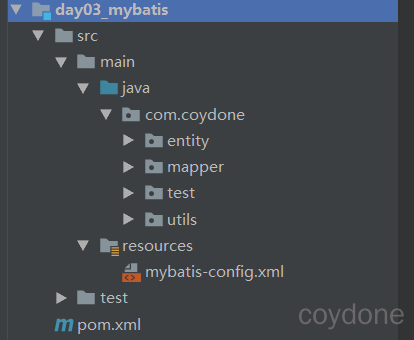准备
数据库介绍
1、grade年级表:字段:年级编号:gid;年级名称:gname。
2、student学生表:字段:学号:xh;学生名:name;年龄:age;性别:sex;birthday:生日;state:状态;地址:address;年级编号:gid。

代码编写思路
-
先建立工程,在pom.xml中配置相应的环境。
-
创建相应的包结构。dao层Mybatis官方推荐命名为Mapper。比如包结构为com.coydone下的entity实体包、mapper映射包(对应以前的dao层)、utils包(存放工具类)、test(测试包)。
-
导入mybatis的配置文件
mybatis-config.xml,查看修改相应的参数。 -
导入相应的工具类。进行封装了的MybatisUtils。
-
编写Mapper方法。
-
在对应的Mapper.xml中编写sql语句。
-
编写测试类。
新建Maven工程,配置pom.xml
<dependencies>
<!-- MySQL依赖-->
<dependency>
<groupId>mysql</groupId>
<artifactId>mysql-connector-java</artifactId>
<version>5.1.47</version>
</dependency>
<!-- 加入MyBatis 依赖-->
<dependency>
<groupId>org.mybatis</groupId>
<artifactId>mybatis</artifactId>
<version>3.5.2</version>
</dependency>
<!--单元测试-->
<dependency>
<groupId>junit</groupId>
<artifactId>junit</artifactId>
<version>4.12</version>
</dependency>
</dependencies>
<build>
<!--配置相关的资源进行打包-->
<resources>
<resource>
<directory>src/main/java</directory>
<includes>
<include>**/*.xml</include>
</includes>
</resource>
<resource>
<directory>src/main/resources</directory>
<includes>
<include>**/*.xml</include>
</includes>
</resource>
</resources>
</build>
创建包结构,导入配置和工具类
项目结构:

mybatis-config.xml
<?xml version="1.0" encoding="UTF-8"?>
<!DOCTYPE configuration PUBLIC "-//mybatis.org//DTD Config 3.0//EN"
"http://mybatis.org/dtd/mybatis-3-config.dtd">
<configuration>
<typeAliases>
<package name="com.coydone.entity"></package>
</typeAliases>
<!-- 指定义连接数据的配置 -->
<environments default="development">
<environment id="development">
<transactionManager type="JDBC"/>
<dataSource type="POOLED">
<property name="driver" value="com.mysql.jdbc.Driver"/>
<property name="url" value="jdbc:mysql://localhost:3306/k0503db?useUnicode=true&characterEncoding=utf-8&useSSL=false"/>
<property name="username" value="root"/>
<property name="password" value="root123"/>
</dataSource>
</environment>
</environments>
<!-- 加载sql映射文件-->
<mappers>
<package name="com.coydone.mapper"/>
</mappers>
</configuration>
MyBatisUtil.java
package com.coydone.utils;
import org.apache.ibatis.io.Resources;
import org.apache.ibatis.session.SqlSession;
import org.apache.ibatis.session.SqlSessionFactory;
import org.apache.ibatis.session.SqlSessionFactoryBuilder;
import java.io.Reader;
public class MyBatisUtil {
private MyBatisUtil(){
}
private static final String RESOURCE = "mybatis-config.xml";
private static SqlSessionFactory sqlSessionFactory = null;
private static ThreadLocal<SqlSession> threadLocal = new ThreadLocal<SqlSession>();
static {
Reader reader = null;
try {
reader = Resources.getResourceAsReader(RESOURCE);
SqlSessionFactoryBuilder builder = new SqlSessionFactoryBuilder();
sqlSessionFactory = builder.build(reader);
} catch (Exception e1) {
e1.printStackTrace();
throw new ExceptionInInitializerError("初始化MyBatis错误,请检查配置文件或数据库");
}
}
public static SqlSessionFactory getSqlSessionFactory(){
return sqlSessionFactory;
}
public static SqlSession getSession(){
//sessionTL的get()方法根据当前线程返回其对应的线程内部变量,
//也就是我们需要的Session,多线程情况下共享数据库链接是不安全的。
//ThreadLocal保证了每个线程都有自己的Session。
SqlSession session = threadLocal.get();
// 如果session为null,则打开一个新的session
if (session == null){
session = (sqlSessionFactory !=null) ?sqlSessionFactory.openSession():null;
threadLocal.set(session); // 5
}
return session;
}
public static void closeSession(){
SqlSession session = (SqlSession) threadLocal.get(); // 2
threadLocal.set(null);
if (session !=null){
session.close();
}
}
}
实体类
Grade.java
package com.coydone.entity;
import java.io.Serializable;
//年级表
public class Grade implements Serializable {
private Integer gid;
private String gname;
//省略构造方法、getter()、setter()方法、toString()方法
}
Student.java
package com.coydone.entity;
import java.io.Serializable;
import java.util.Date;
public class Student implements Serializable {
private Integer xh;
private String name;
private Integer age;
private String sex;
private Date birthday;
private Integer state;
private String address;
private Integer gid;
//省略构造方法、getter()、setter()方法、toString()方法
}
进行功能的编码及测试
-
遵循一功能一方法、一数据表一实体类一映射。
-
注意增删改操作需要提交SQL事务。
对Student表进行单表CURD操作:
查询所有学生
//在mapper包下创建StudentMapper接口
public interface StudentMapper {
List<Student> findAll();
}
//在mapper包下创建StudentMapper.xml
<?xml version="1.0" encoding="UTF-8"?>
<!DOCTYPE mapper PUBLIC "-//mybatis.org//DTD Mapper 3.0//EN"
"http://mybatis.org/dtd/mybatis-3-mapper.dtd">
<!--指定命名空间为mapper包下的StudentMapper id与方法名对应-->
<mapper namespace="com.coydone.mapper.StudentMapper">
<select id="findAll" resultType="Student">
select * from student
</select>
</mapper>
//编写测试类 使用单元测试
import org.junit.Test;
import java.text.ParseException;
import java.text.SimpleDateFormat;
import java.util.*;
public class StudentTest {
//通过工具类获取sqlSession对象,再获取出对应的映射对象,studentMapper就可以调用定义的方法了。
SqlSession sqlSession = MyBatisUtil.getSession();
StudentMapper studentMapper = sqlSession.getMapper(StudentMapper.class);
@Test
public void findAll(){
List<Student> students = studentMapper.findAll();
for (Student student : students) {
System.out.println(student);
}
}
}
通过主键查询单个学生
//StudentMapper接口下的方法
Student findById(Integer xh);
//StudentMapper.xml下的sql配置
<select id="findById" parameterType="int" resultType="Student">
select * from student where xh = #{xh}
</select>
//测试
@Test
public void findById(){
Scanner input=new Scanner(System.in);
System.out.println("请输入要查询的学号:");
int xh =input.nextInt();
Student student = studentMapper.findById(xh);
System.out.println(student);
}
添加学生
//StudentMapper接口下的方法
int addStudent(Student student);
//StudentMapper.xml下的sql配置
<insert id="addStudent" parameterType="Student">
insert into student(xh,name,age,sex,birthday,state,address,gid) values(#{xh},#{name},#{age},#{sex},#{birthday},#{state},#{address},#{gid})
</insert>
//测试
@Test
public void addStudent(){
Scanner input=new Scanner(System.in);
System.out.println("请输入学号:");
int xh=input.nextInt();
System.out.println("请输入姓名:");
String name=input.next();
System.out.println("请输入年龄:");
int age =input.nextInt();
System.out.println("请输入性别:");
String sex=input.next();
System.out.println("请输入生日:");
String birthday =input.next();
SimpleDateFormat sdf = new SimpleDateFormat("yyyy-MM-dd");
Date date = null;
try {
date = sdf.parse(birthday);
} catch (ParseException e) {
e.printStackTrace();
}
System.out.println("请输入状态:");
int state=input.nextInt();
System.out.println("请输入地址:");
String address=input.next();
System.out.println("请输入gid:");
int gid=input.nextInt();
Student student = new Student(xh,name,age,sex,date,state,address,gid);
int rows = studentMapper.addStudent(student);
sqlSession.commit();
if(rows>0)
System.out.println("添加成功");
else
System.out.println("添加失败");
}
根据主键修改
//StudentMapper接口下的方法
int updateStudent(Student student);
//StudentMapper.xml下的sql配置
<update id="updateStudent" parameterType="Student">
update student set name = #{name},address = #{address} where xh = #{xh}
</update>
//测试 先通过主键查询查询出单个的学生,存入student对象中,在修改student。
@Test
public void updateStudent(){
Scanner input=new Scanner(System.in);
System.out.println("请输入要修改的学号:");
int xh=input.nextInt();
System.out.println("请输入修改的姓名:");
String name=input.next();
System.out.println("请输入修改的地址:");
String address=input.next();
Student student = studentMapper.findById(xh);
student.setName(name);
student.setAddress(address);
int rows = studentMapper.updateStudent(student);
sqlSession.commit();
if(rows>0)
System.out.println("修改成功");
else
System.out.println("修改失败");
}
根据主键删除
//StudentMapper接口下的方法
int deleteStudent(Integer xh);
//StudentMapper.xml下的sql配置
<delete id="deleteStudent" parameterType="int" >
delete from student where xh = #{xh}
</delete>
//测试
@Test
public void deleteStudent(){
Scanner input=new Scanner(System.in);
System.out.println("请输入要删除的学号:");
int xh=input.nextInt();
int rows = studentMapper.deleteStudent(xh);
sqlSession.commit();
if(rows>0)
System.out.println("删除成功");
else
System.out.println("删除失败");
}
实现条件查询
我们可以将查询所需的条件封装成一个实体类。每次需要增加条件时只需要在其实体类中添加一个属性。
package com.coydone.entity;
import java.io.Serializable;
//学生条件
public class StudentCondition implements Serializable {
private String name;
private Integer startAge;
private Integer endAge;
private String address;
//省略getter和setter方法
}
//StudentMapper接口下的方法
List<Student> findStudentByCondition(StudentCondition condition);
//StudentMapper.xml下的sql配置
<select id="findStudentByCondition" parameterType="StudentCondition" resultType="Student">
select * from student where 1=1
<if test="name!=null">
and name like concat('%',#{name},'%')
</if>
<if test="startAge!=null">
and age > #{startAge}
</if>
<if test="endAge!=null">
and age < #{endAge}
</if>
<if test="address!=null">
and address like concat('%',#{address},'%')
</if>
</select>
//测试
@Test
public void findByConditon(){
Scanner input=new Scanner(System.in);
System.out.println("请输入要查询的姓名:");
String name =input.nextLine();
System.out.println("请输入起始年龄:");
String startAge =input.nextLine();
System.out.println("请输入结束年龄:");
String endAge =input.nextLine();
System.out.println("请输入地址:");
String address =input.nextLine();
StudentCondition condition = new StudentCondition();
if (name!=null&&!name.equals("")){
condition.setName(name);
}
if (!startAge.equals("")){
condition.setStartAge(Integer.parseInt(startAge));
}
if (!endAge.equals("")){
condition.setEndAge(Integer.parseInt(endAge));
}
if (!address.equals("")){
condition.setAddress(address);
}
List<Student> students = studentMapper.findStudentByCondition(condition);
for (Student student : students) {
System.out.println(student);
}
//关闭sqlSession
MyBatisUtil.closeSession();
}
多条件分页查询
分页所需的两个参数为当前记录的索引值和每页显示的记录数。所以我们要先条件查询表的总记录数,在通过总记录数和每页显示的记录数可以获取出总页码数。分页的条件我们可以重新封装为一个PageUtils工具类。再将查询的参数和分页的查询使用Map集合进行存储。
package com.coydone.utils;
public class PageUtils {
private Integer currentPage;//当前页
private Integer startIndex;//开始索引
private Integer pageSize=5;//每页显示条数
private Integer totalCount;//总记录数
private Integer totalPage;//总页数
public Integer getCurrentPage() {
return currentPage;
}
public void setCurrentPage(Integer currentPage) {
this.currentPage = currentPage;
this.startIndex=(this.currentPage-1)*this.pageSize;
}
public Integer getPageSize() {
return pageSize;
}
public void setPageSize(Integer pageSize) {
this.pageSize = pageSize;
}
public Integer getTotalCount() {
return totalCount;
}
public void setTotalCount(Integer totalCount) {
this.totalCount = totalCount;
//计算总页数
this.totalPage=(int)Math.ceil((this.totalCount*1.0/this.pageSize));
}
public Integer getTotalPage() {
return totalPage;
}
public void setTotalPage(Integer totalPage) {
this.totalPage = totalPage;
}
public Integer getStartIndex() {
return startIndex;
}
public void setStartIndex(Integer startIndex) {
this.startIndex = startIndex;
}
}
//条件查询表的总记录数
int findCounts(StudentCondition condition);
<select id="findCounts" parameterType="StudentCondition" resultType="int">
select count(1) from student where 1=1
<if test="name!=null">
and name like concat('%',#{name},'%')
</if>
<if test="startAge!=null">
and age > #{startAge}
</if>
<if test="endAge!=null">
and age < #{endAge}
</if>
<if test="address!=null">
and address like concat('%',#{address},'%')
</if>
</select>
@Test
//条件查询总记录数
public void findCounts(){
Scanner input=new Scanner(System.in);
System.out.println("请输入要查询的姓名:");
String name =input.nextLine();
System.out.println("请输入起始年龄:");
String startAge =input.nextLine();
System.out.println("请输入结束年龄:");
String endAge =input.nextLine();
System.out.println("请输入地址:");
String address =input.nextLine();
StudentCondition condition = new StudentCondition();
if (name!=null&&!name.equals("")){
condition.setName(name);
}
if (!startAge.equals("")){
condition.setStartAge(Integer.parseInt(startAge));
}
if (!endAge.equals("")){
condition.setEndAge(Integer.parseInt(endAge));
}
if (!address.equals("")){
condition.setAddress(address);
}
int counts = studentMapper.findCounts(condition);
System.out.println(counts);
//关闭sqlSession
MyBatisUtil.closeSession();
}
//多条件分页查询
List<Student> findAllByLimit(Map<String, Object> map);
<select id="findAllByLimit" parameterType="map" resultType="Student">
select * from student where 1=1
<if test="name!=null">
and name like concat('%',#{name},'%')
</if>
<if test="startAge!=null">
and age > #{startAge}
</if>
<if test="endAge!=null">
and age < #{endAge}
</if>
<if test="address!=null">
and address like concat('%',#{address},'%')
</if>
limit #{startIndex},#{pageSize}
</select>
@Test
//多条件分页查询
public void findAllByLimit(){
Scanner input=new Scanner(System.in);
System.out.println("请输入要查询的姓名:");
String name =input.nextLine();
System.out.println("请输入起始年龄:");
String startAge =input.nextLine();
System.out.println("请输入结束年龄:");
String endAge =input.nextLine();
System.out.println("请输入地址:");
String address =input.nextLine();
PageUtils pageUtils = new PageUtils();
//设置当前页
pageUtils.setCurrentPage(1);
//设置每页显示的总条数
pageUtils.setPageSize(5);
StudentCondition condition = new StudentCondition();
int counts = studentMapper.findCounts(condition);
pageUtils.setTotalCount(counts);
Map<String , Object> map = new HashMap<>();
if (name!=null&&!name.equals("")){
map.put("name", name);
}
if (!startAge.equals("")){
map.put("startAge", startAge);
}
if (!endAge.equals("")){
map.put("endAge", endAge);
}
if (!address.equals("")){
map.put("address", address);
}
map.put("startIndex", pageUtils.getStartIndex());
map.put("pageSize", pageUtils.getPageSize());
List<Student> students = studentMapper.findAllByLimit(map);
for (Student student : students) {
System.out.println(student);
}
System.out.println("当前第"+pageUtils.getCurrentPage()+"页,共"+counts+"条");
//关闭sqlSession
MyBatisUtil.closeSession();
}
多表连接查询
多表查询在本案例中有两种:
多对一:查询所有学生的信息同时将其所在的年级信息查询出来。此时学生表为主表,年级表为从表,我们要在主表中添加从表的属性。又因为一个学生只能对应一个年级,所有我们可以直接添加年级的属性值(推荐),在从表中属性过多的时候,我们添加从表的对象会比较方便(情况很少,不推荐)。
一对多:查询年级信息及每个年级下的所有学生。此时年级表为主表,学生表为从表,一个年级下存在着多个学生,我们需要在年级表中采用泛型集合的方式List<Student>。
查询所有学生及所在年级
方式一
//在Student表中添加年级表属性
private String gname;
//添加getter和setter方法(省略)
//在StudentMapper中写查询方法
List<Student> findAllStudentAndGrade();
//在StudentMapper.xml中写查询方法sql
<select id="findAllStudentAndGrade" resultType="Student">
SELECT s.*,g.gname FROM student s LEFT JOIN grade g ON s.gid=g.gid
</select>
//测试
@Test
public void findAllStudentAndGrade(){
List<Student> studentAndGrade = studentMapper.findAllStudentAndGrade();
for (Student student : studentAndGrade) {
System.out.println(student+student.getGname());
}
}
方式二
//添加年级对象
private Grade grade;
//添加getter和setter方法(省略)
List<Student> findAllStudentAndGrade2();
//此时返回的查询结果为两张表的复杂类型,我们通过association来映射对应的实体Grade
<resultMap id="result" type="Student">
<id column="xh" property="xh"></id>
<result column="name" property="name"></result>
<result column="age" property="age"></result>
<result column="sex" property="sex"></result>
<result column="birthday" property="birthday"></result>
<result column="state" property="state"></result>
<result column="address" property="address"></result>
<association property="grade" javaType="Grade">
<result column="gname" property="gname"></result>
</association>
</resultMap>
<select id="findAllStudentAndGrade2" resultMap="result">
SELECT s.*,g.gname FROM student s LEFT JOIN grade g ON s.gid=g.gid
</select>
//测试
@Test
public void findAllStudentAndGrade2(){
List<Student> allStudentAndGrade2 = studentMapper.findAllStudentAndGrade2();
for (Student student : allStudentAndGrade2) {
System.out.println(student+student.getGrade().getGname());
}
}
查询所有年级及每个年级所有的学生
//在grade表中添加Student表的list集合
private List<Student> students;
//添加getter和setter方法(省略)
//在GradeMapper中写查询方法
List<Grade> findAllGradeAndStudent();
//在GradeMapper.xml中写查询方法sql
//此时查询的结果为复杂类型,只能用resultMap,使用collection将从表中的数据以list集合形式返回
<resultMap id="gradesAndStu" type="Grade">
<id column="gid" property="gid"></id>
<result column="gname" property="gname"></result>
<collection property="students" ofType="Student">
<id column="xh" property="xh"></id>
<result column="name" property="name"></result>
<result column="age" property="age"></result>
<result column="sex" property="sex"></result>
<result column="birthday" property="birthday"></result>
<result column="state" property="state"></result>
<result column="address" property="address"></result>
</collection>
</resultMap>
<select id="findAllGradeAndStudent" resultMap="gradesAndStu">
SELECT g.*,s.* FROM grade g LEFT JOIN student s ON g.gid=s.gid ORDER BY g.gid ASC
</select>
//测试
@Test
public void findAllGradeAndStudent(){
List<Grade> gradeAndStudent = gradeMapper.findAllGradeAndStudent();
for (Grade grade : gradeAndStudent) {
System.out.println(grade.getGname());
List<Student> students = grade.getStudents();
for (Student student : students) {
System.out.println(student);
}
}
}





评论区